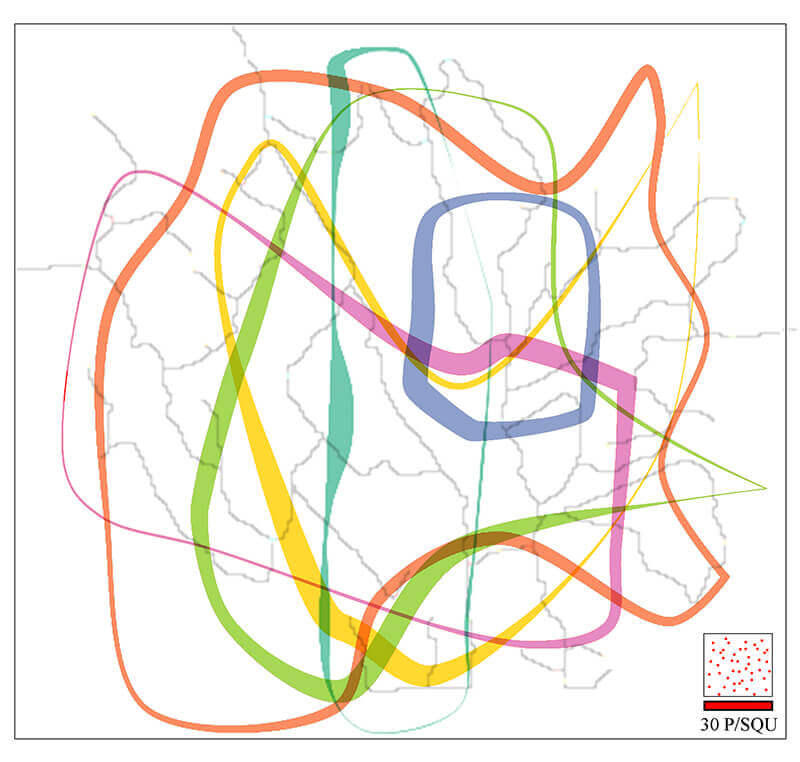July 23, 2019
Don’t bring the heat: New visualization technique offers alternative to heat maps to track spatial data sets
 Purdue University researchers have developed a visualization technique that could make using big spatial data sets simpler and more concise. (Stock photo)
Download image
Purdue University researchers have developed a visualization technique that could make using big spatial data sets simpler and more concise. (Stock photo)
Download image
Simple, concise approach designed to make data easier to understand, compare
WEST LAFAYETTE, Ind. – Heat maps or points on a map can be simple and typically effective ways to visualize spatial data sets. But when that data involves many different types of objects – such as planning resources for a city or tracking possible enemy locations for military strategy – these conventional visualization methods can make it nearly impossible to categorize and compare data.
Purdue University researchers have developed a visualization technique that could make using big spatial data sets simpler and more concise. Their technique simplifies points on a map into boundaries with various segment widths, making spatial distributions of a large number of objects in different groups or over time easier to understand, analyze and use for decision making or future events prediction.
 The Purdue visualization technique simplifies points on a map into boundaries with various segment widths, making spatial distributions of a large number of objects in different groups or over time easier to understand, analyze and use for decision making or future events prediction. (Image provided)
Download image
The Purdue visualization technique simplifies points on a map into boundaries with various segment widths, making spatial distributions of a large number of objects in different groups or over time easier to understand, analyze and use for decision making or future events prediction. (Image provided)
Download image
“We created a simple way to overlay multiple layers on top of each other to make comparisons in distributions easier,” said Yingjie Chen, as associate professor of computer graphics technology in the Purdue Polytechnic Institute. “Our experiments have shown that this technique is intuitive and easy for a user to understand the information being shown.”
Chen said the Purdue visualization technique uses a specially designed algorithm that incorporates information about thickness, density and boundaries tied to data points. Objects can be grouped by type or time, allowing users to see changes in distributions over time.
“Data visualization continues to be a growing field,” Chen said. “Our technique could be used to study nature phenomena, track political affiliations within a geographic region and many other areas where data can help in comparison and future planning.”
Chen and students in his Purdue Intelligent Visualization and Interaction Laboratory (PIVIL) worked with Zhenyu Cheryl Qian, an associate professor of interaction design in Purdue’s College of Liberal Arts, to create their abstract visualization of spatial distributions technique.
The researchers worked with the Purdue Research Foundation Office of Technology Commercialization to patent the technology. They are looking for additional partners and those interested in licensing the technology.
About Purdue Research Foundation Office of Technology Commercialization
The Purdue Research Foundation Office of Technology Commercialization operates one of the most comprehensive technology transfer programs among leading research universities in the U.S. Services provided by this office support the economic development initiatives of Purdue University and benefit the university's academic activities through commercializing, licensing and protecting Purdue intellectual property. The office is managed by the Purdue Research Foundation, which received the 2016 Innovation and Economic Prosperity Universities Award for Innovation from the Association of Public and Land-grant Universities. For more information on licensing a Purdue innovation, contact the Office of Technology Commercialization at otcip@prf.org. For more information about funding and investment opportunities in startups based on a Purdue innovation, contact the Purdue Foundry at foundry@prf.org.The Purdue Research Foundation is a private, nonprofit foundation created to advance the mission of Purdue University.
Writer: Chris Adam, 765-588-3341, cladam@prf.org
Source: Yingjie Chen, victorchen@purdue.edu

